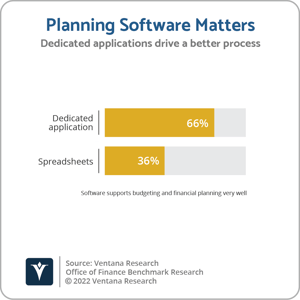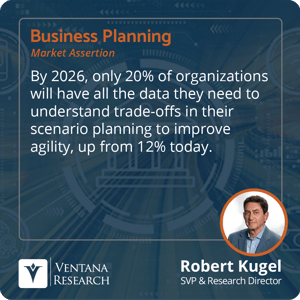We live in a time of uncertainty, not unpredictability. Managing an organization in uncertain times is always hard, but tools are available to improve the odds for success by making it easier and faster to plan for contingencies and scenarios. Software makes it possible to quickly consider the impact of a range of events or assumptions and devise a set of plans to deal with them. Dedicated planning and budgeting software has been around for decades but is about to become all the more useful as vendors increasingly incorporate artificial intelligence using machine learning to assist in scenario planning. Organizations can quickly investigate the impact of different contingencies and the consequences of a range of reactions to them.
In the 2000s, I coined the term integrated business planning to describe an approach to planning and budgeting that’s faster, more dynamic and, therefore, more accurate and adaptable as events unfold. IBP is a technology- and process-driven approach to business planning. It connects all the forward-looking activities in which organizations routinely engage into a unified process using shared, consistent data. This includes marketing, sales, customer, supply chain and workforce planning as well as budgeting. It can substantially cut the time spent creating and updating plans, making it possible for financial planning and analysis groups to rapidly develop detailed assessments of the impact of different scenarios. IBP gives senior executives the ability to quickly explore different scenarios and their potential impact. It provides the necessary information to assess alternatives, and it does so in quick order to make planning actionable.
Today’s business planning challenges are the result of rapid evolution of secular trends in markets, economies and politics as well as impactful events that accompany these sea changes. It’s no longer adequate  to answer what-if questions with “I’ll get back to you with that,” because successfully planning next steps in a dynamic environment requires a free-flowing dialog. Today’s planning applications achieve speedy scenario development, helping good managers make better decisions faster and more consistently. Our Office of Finance Benchmark Research found that 66% of organizations that use a dedicated planning application have a process that works very well, compared to 36% that use stand-alone spreadsheets.
to answer what-if questions with “I’ll get back to you with that,” because successfully planning next steps in a dynamic environment requires a free-flowing dialog. Today’s planning applications achieve speedy scenario development, helping good managers make better decisions faster and more consistently. Our Office of Finance Benchmark Research found that 66% of organizations that use a dedicated planning application have a process that works very well, compared to 36% that use stand-alone spreadsheets.
Contingency planning is at the heart of good management. When reviewing organizational operating and financial plans, the best executives I’ve known always ask, “What will you do when your plan doesn’t work?” Contingency planning provides thoughtful answers to that question, including the impact of various scenarios on financial statements, profitability, market share and operating metrics. Having the ability to rapidly model and plan different scenarios at a useful level of detail enables organizations to assess different options more frequently and pivot quickly when conditions change enough to warrant it.
By streamlining planning and budgeting cycles, IBP makes it possible for executives and managers to have the time to assess different scenarios and contingencies. Business is all about managing trade-offs because resources are always limited. Yet because organizations lack the technology to perform short planning cycles, our research reveals that 58% of businesses of all types and sizes have little or no ability to measure trade-offs in the plans in which they are involved. Being able to include operational resources – not just the financials – provides business managers and executives with a clearer picture of the impact of various scenarios – and the means to formulate a coordinated, consistent response. For a majority of organizations, that’s difficult to achieve. Just 12% have all the numbers needed to assess such trade-offs, and only 30% have most of the necessary data.
Three out of five organizations that use dedicated planning applications have all or most of the numbers needed, compared to only about one-third of those using spreadsheets. This capability is especially valuable in periods of rapid change because detailed responses to specific scenarios can be updated at short intervals. Unfortunately, while I expect some improvement, lack of data is likely to hamper planning efforts: Ventana Research asserts that by 2026, only 20% – up from 12% today – will have all the data needed to understand trade-offs in scenario planning and improve agility. The best planning software will not achieve its potential if data availability is inadequate. The best planning software will not achieve its potential if data availability is inadequate.
rapid change because detailed responses to specific scenarios can be updated at short intervals. Unfortunately, while I expect some improvement, lack of data is likely to hamper planning efforts: Ventana Research asserts that by 2026, only 20% – up from 12% today – will have all the data needed to understand trade-offs in scenario planning and improve agility. The best planning software will not achieve its potential if data availability is inadequate. The best planning software will not achieve its potential if data availability is inadequate.
To be truly effective, contingency planning must include operational and financial budgeting. In planning, executives and managers almost always think about things such as units of production and headcount, not just money. Planning for units is essential. For instance, if a port strike is threatened, organizations need to assess how that will affect product availability. If the shutdown stretches into weeks or months, what is the best response, including the optimal allocation of available product? In a mild recession, allocating resources to sustain efforts in attractive markets while cutting less strategic investments can provide a competitive edge. Executives must be able to accurately evaluate the impact of multiple scenarios on the business to understand their options and trade-offs. And doing so requires a planning and budgeting process that’s accurate, efficient and fast.
I recommend that all midsize and larger organizations adopt dedicated planning and budgeting software to improve performance. It’s also essential to craft a data management strategy that incorporates a data pantry to support better planning, and, potentially, a planning center of excellence to manage the process. We live in an age of the uncertain, not the unpredictable. Technology enables senior leadership teams to manage more intelligently to achieve greater resiliency and agility.
Regards,
Robert Kugel

 to answer what-if questions with “I’ll get back to you with that,” because successfully planning next steps in a dynamic environment requires a free-flowing dialog. Today’s planning applications achieve speedy scenario development, helping good managers make better decisions faster and more consistently. Our Office of Finance Benchmark Research found that 66% of organizations that use a dedicated planning application have a process that works very well, compared to 36% that use stand-alone spreadsheets.
to answer what-if questions with “I’ll get back to you with that,” because successfully planning next steps in a dynamic environment requires a free-flowing dialog. Today’s planning applications achieve speedy scenario development, helping good managers make better decisions faster and more consistently. Our Office of Finance Benchmark Research found that 66% of organizations that use a dedicated planning application have a process that works very well, compared to 36% that use stand-alone spreadsheets. rapid change because detailed responses to specific scenarios can be updated at short intervals. Unfortunately, while I expect some improvement, lack of data is likely to hamper planning efforts: Ventana Research asserts that by 2026, only 20% – up from 12% today – will have all the data needed to understand trade-offs in scenario planning and improve agility. The best planning software will not achieve its potential if data availability is inadequate. The best planning software will not achieve its potential if data availability is inadequate.
rapid change because detailed responses to specific scenarios can be updated at short intervals. Unfortunately, while I expect some improvement, lack of data is likely to hamper planning efforts: Ventana Research asserts that by 2026, only 20% – up from 12% today – will have all the data needed to understand trade-offs in scenario planning and improve agility. The best planning software will not achieve its potential if data availability is inadequate. The best planning software will not achieve its potential if data availability is inadequate.








